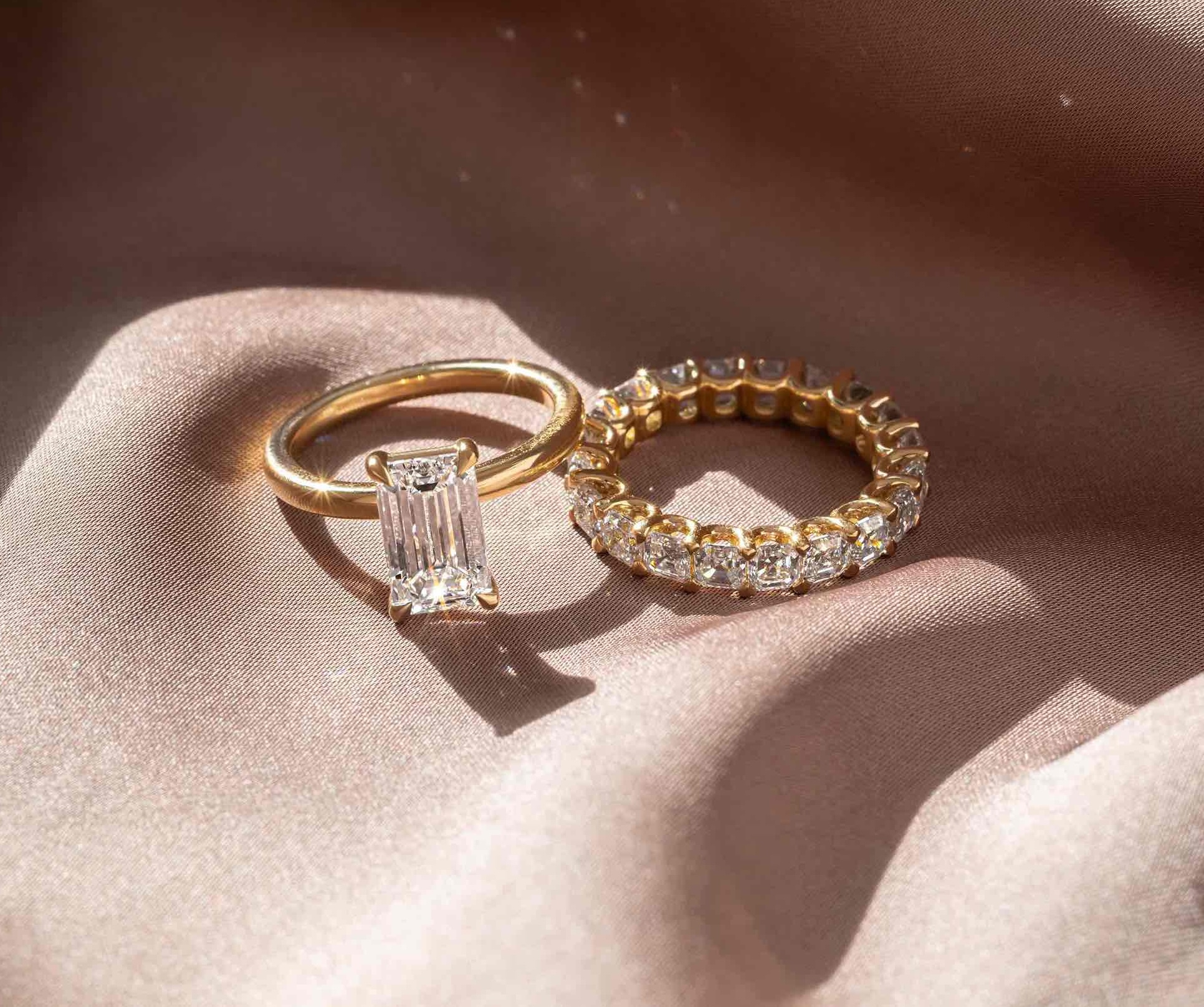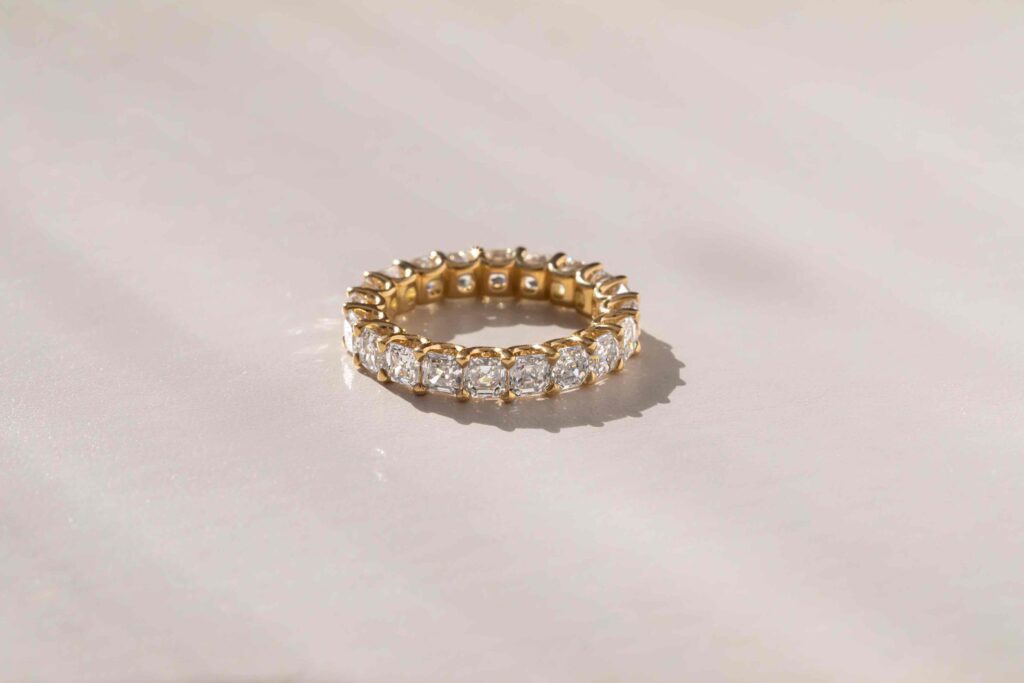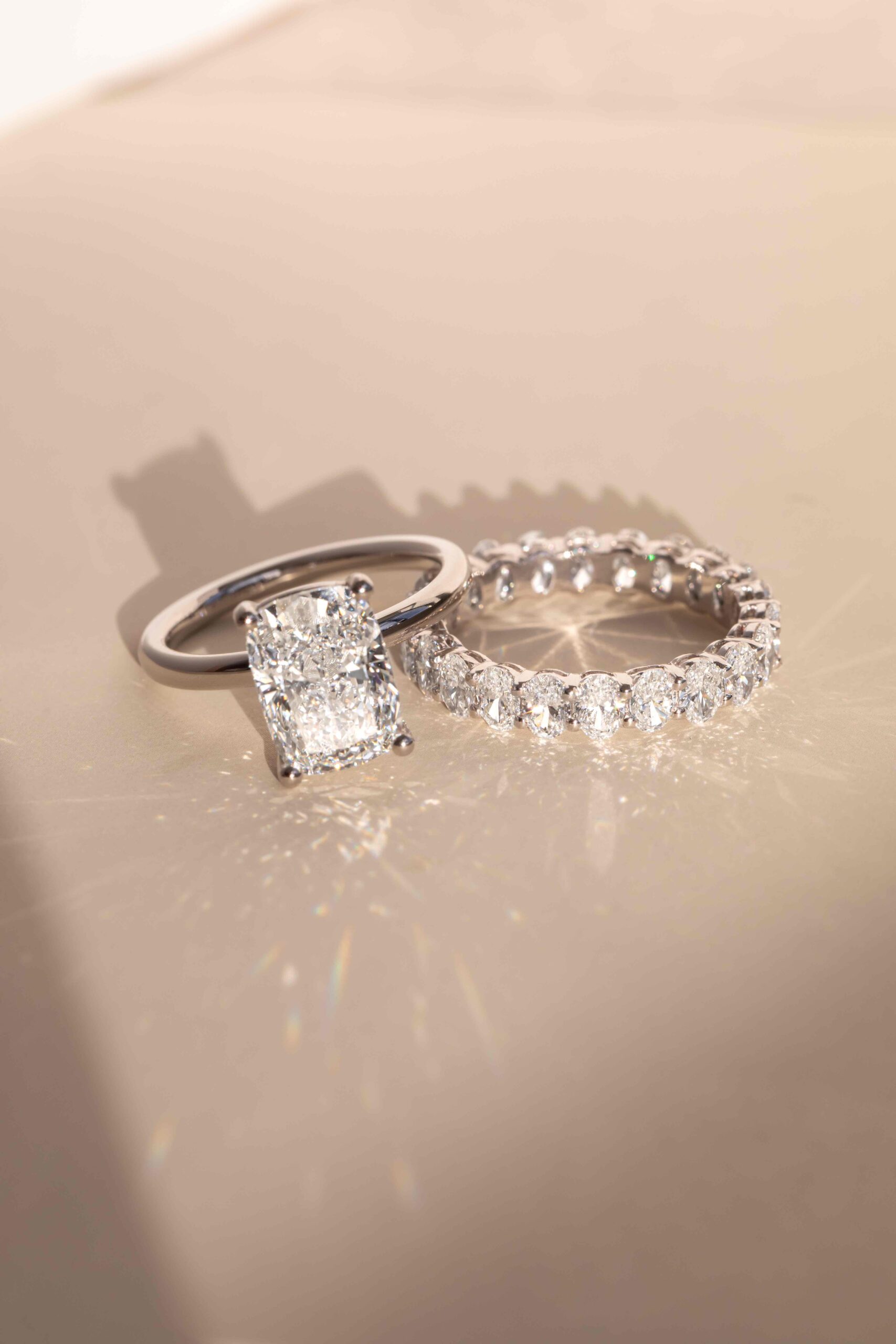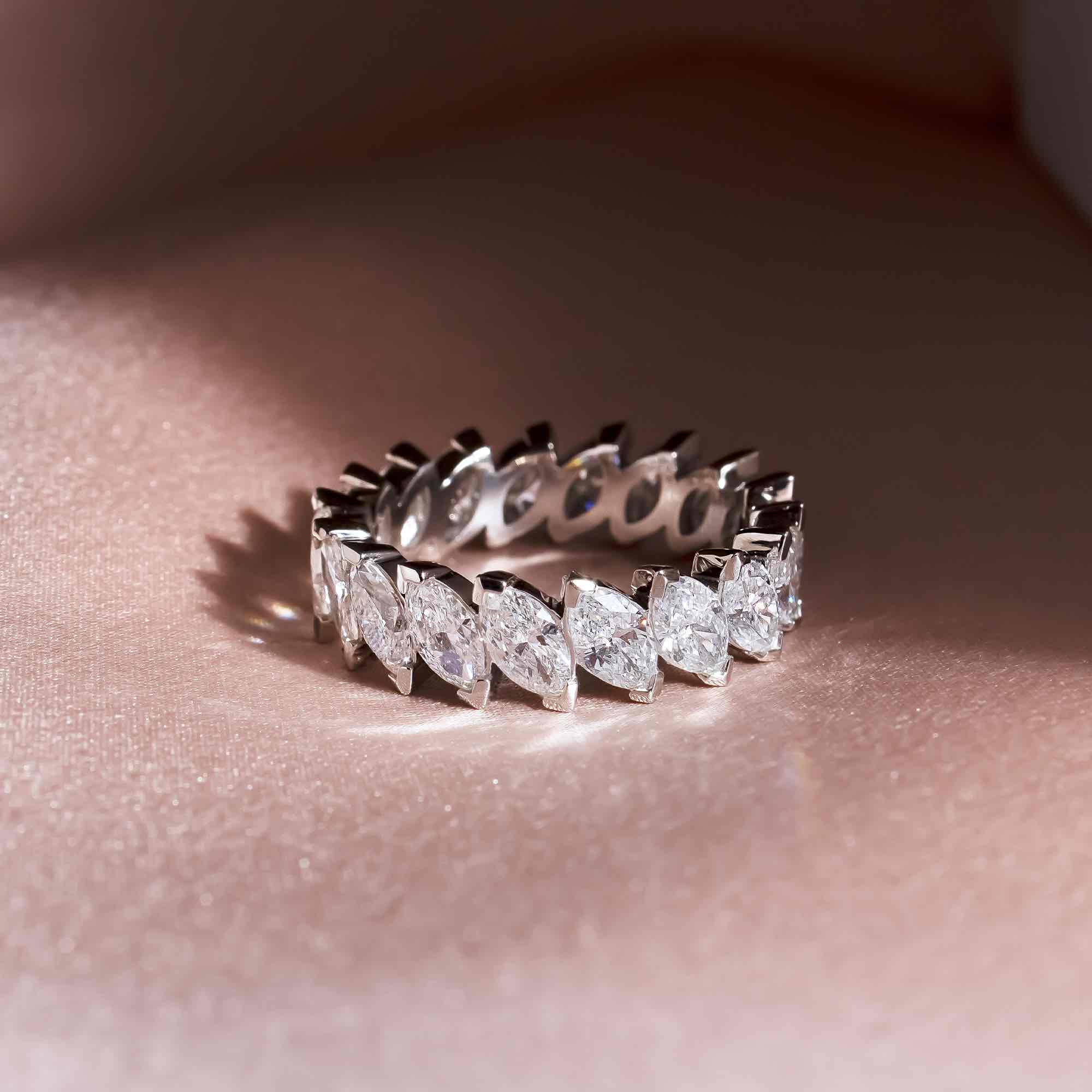
1 Jul 2025 — by Flawless Fine Jewellery — Reading time 12 minutes
How to Choose the Perfect Eternity Ring: Metals, Stones & Settings
The Knowledge You Need To Find Your Perfect Gemstone
Introduction
An eternity ring is more than a piece of jewellery; it can symbolize lasting love and shared milestones. It may be an anniversary gift, or a celebration of a child’s birth, or simply a romantic gift to show your partner your love. An eternity ring marks a moment in time with radiant elegance. However, how do you choose from many styles, settings and materials? Which is the best eternity ring?

Topics covered
The Meaning Behind Eternity Rings
So, what does an eternity ring symbolize? Traditionally, eternity rings symbolize everlasting love with their unbroken circle of diamonds or precious stones. Eternity rings are often gifted after marriage to celebrate a couple’s significant milestones together, making the ring meaningful and extravagant. Unlike wedding bands, which are exchanged during marriage, eternity rings are typically given later, introducing a significant new symbol to commemorate their memory.
In several cultures, eternity rings are often chosen as engagement or wedding rings due to their unique design, especially when a couple is looking for an alternative to the traditional rings. The symbolism of eternity rings creates value in their meaning rather than just aesthetic appearance.

Eternity Ring Styles: Full or Half?
One of the first steps you take when you think about style is to decide on the full eternity ring vs the half eternity ring. The full eternity ring has stones that go all the way around the band of the ring, offering a uniform sparkle from every angle. This style is meaningful, but can represent a challenge for resizing.
The half eternity ring, on the other hand, has stones that are set across the top of the band. This style is often more comfortable for daily wear and is generally easier to resize if you need to do so, and ideal if you like a little understated elegance with functionality.
Both of these eternity ring styles have their appeal. If you would like something that really makes a bold statement and allows you to shine with sparkle from every angle, then a full design would be perfect for you. If comfort and adaptability are what you are looking for, then a half design would work out great for you.

The Brilliance of Diamond Eternity Rings
A diamond eternity ring is still the most popular choice, and it’s easy to see why: diamonds symbolize strong and everlasting beauty. At Flawless Fine Jewellery, we use many premium lab-grown diamonds to create even more sustainable luxury while maintaining all the same fine qualities. Whether the eternity ring is set in platinum or gold, diamonds provide a classic brilliance for everyone’s style.
For those looking for something more unconventional, use colored stones like sapphires, rubies or emeralds while mixing in diamonds for a personal touch. Many combinations of stones can be used to signify birthstones, special anniversaries or commonalities between couples to create a beautiful ring, not just a stunning ring.
Choosing the Right Metal
The metal you choose has a big impact on the overall look and durability of eternity rings. The strength and naturally white appearance of platinum make it a popular choice because it enhances any sparkle from diamonds. Yellow gold offers a classic warm tone, and it will complement all kinds of vintage-inspired rings. Rose gold is becoming a more fashionable choice because of its softer, romantic appearance and is available for custom and contemporary designs.
Metal also plays a role in comfort and wear if it is suitable for wearing on an everyday basis. Platinum is slightly heavier and more durable than gold, which you may prefer for everyday wear, in which case platinum would be a more ideal choice. Gold, on the other hand, is lighter than platinum and is also chosen more frequently for its elegance and classic finish. The ultimate decision should depend on your personal preferences, match your skin tone’s metal, and consider how the ring will be worn with other rings (if you have them).

Eternity Ring Settings to Consider
Eternity ring settings determine how the stones are held in place, which impacts the appearance and durability of the ring. Common settings include:
- Pavé: Very small diamonds that are set very close together for a delicate and continuous sparkle.
- Channel: Stones are set in between two bands of metal, and this type of setting is well-suited for people with active lifestyles.
- Shared prong: Minimal amount of metal, emphasises maximum light reflection and brilliance.
Each of the setting types has a different balance of security, sparkle and elegance. So, consider these factors: how often will you wear the ring and your personal style preferences?
Eternity Ring vs Wedding Ring: What’s the Difference?
While both represent love, an eternity ring vs a wedding ring comes down to timing and tradition. A wedding ring is exchanged as part of the wedding ceremony to seal the love through legal formalities. An eternity ring is usually given at a later date to signify an ongoing journey and commitment. As a rule, an eternity ring is worn along with a wedding ring or on the opposite hand; the eternity ring never replaces the wedding ring.
Some people also stack their eternity ring with their engagement and wedding rings to achieve a lovely layered look, symbolizing all the different phases of their relationship.
Which Eternity Ring Is Best?
The ideal eternity ring will be based on a few key considerations:
Your lifestyle: A half eternity ring with a secure channel would be perfect for someone who uses their hands a lot.
Aesthetics: Do you prefer striking sparkle, a range of colored stones, or minimal detailing?
Your budget: As a general rule, full eternity rings and platinum bands will be more expensive, but lab-grown diamonds are more cost-effective and sparkle just as beautifully as mined ones.
If you want to find a bespoke ring, Flawless Fine Jewellery offers an impressive selection of handcrafted eternity rings which can be viewed online or in-store (Manchester or Hatton Garden Store). You can also explore bespoke options to create something as unique as your love story.
FAQs About Eternity Rings
Q: What is the difference between a full and half eternity ring?
A full eternity ring has stones set all the way around the band, while a half eternity ring features stones only across the top half. Full eternity rings are more symbolic but may be less practical for daily wear, whereas half eternity rings are more comfortable and often more affordable.
Q: When should I give or receive an eternity ring?
Eternity rings are commonly given to mark significant milestones such as a wedding anniversary (typically the 1st, 10th, or later), the birth of a child, or any moment that represents lasting love and commitment.
Q: Can an eternity ring be used as a wedding or engagement ring?
Yes, eternity rings can serve as wedding or even engagement rings, especially for those who prefer a more modern or alternative style. Some couples also use them as stackable rings alongside traditional bridal sets.
Q: Which finger do you wear an eternity ring on?
Traditionally, eternity rings are worn on the ring finger of the left hand, alongside the engagement and wedding rings. However, they can also be worn on the right hand or any finger, depending on personal preference and comfort.
Q: How do I care for my eternity ring?
To maintain its sparkle, clean your eternity ring regularly with a gentle jewelry cleaner or mild soap and water. Avoid harsh chemicals and store it safely when not in use. Periodic professional cleanings and inspections are recommended.
Q: Are eternity rings only for women?
No, while traditionally marketed toward women, eternity rings are increasingly popular with men as well. Unisex and masculine styles are available, making them a meaningful gift for anyone.
Q: What do the stones in an eternity ring symbolize?
Each stone typically represents a special moment, year, or commitment in a relationship. The continuous circle of gems is a powerful symbol of eternal love, unity, and unbreakable bonds.
